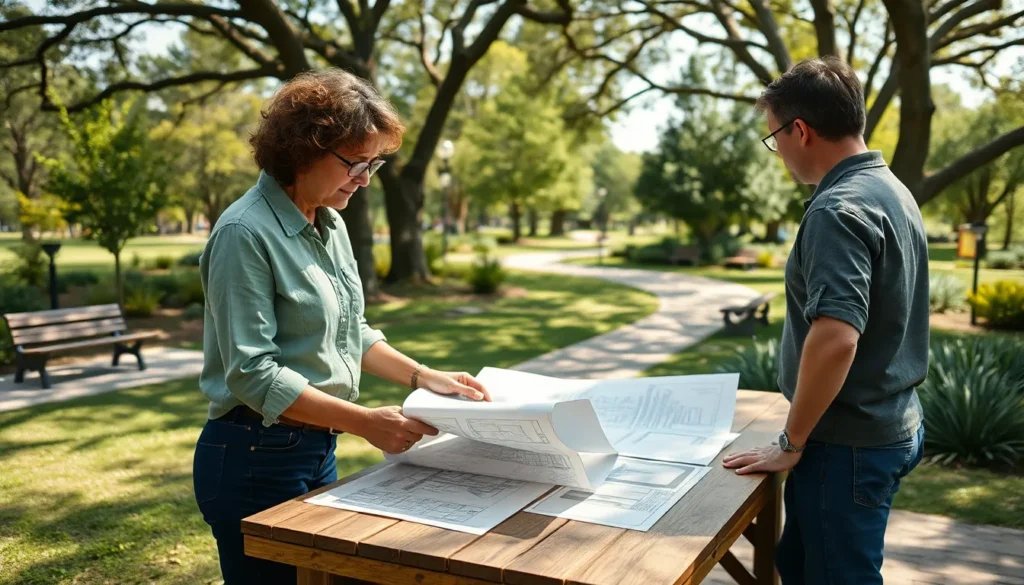Table of Contents
ToggleLandscape architects are the unsung heroes of outdoor spaces, transforming mundane patches of grass into breathtaking vistas. They blend creativity with science, crafting environments that not only look stunning but also function beautifully. Whether it’s designing a serene park for relaxation or a vibrant urban plaza for social gatherings, these professionals know how to make nature and humanity coexist in harmony.
Imagine strolling through a park where every flower seems to be smiling at you and every bench is perfectly positioned for that Instagram-worthy shot. That’s the magic of landscape architecture. With a keen eye for detail and a passion for sustainability, these architects create spaces that invite people to connect with nature and each other. So, next time you enjoy a sunny day in a well-designed garden, take a moment to appreciate the artistry and expertise that brought it to life.
Overview of Landscape Architects
Landscape architects play a crucial role in shaping outdoor environments. They design public spaces, parks, gardens, and recreational areas, focusing on both aesthetics and functionality. Recognizing the interplay between nature and human activity, they create spaces that blend seamlessly with their surroundings.
Education and training are essential for landscape architects. Most possess a bachelor’s or master’s degree in landscape architecture, which includes studies in design, ecology, and environmental sustainability. Professional licensure often follows formal education, ensuring adherence to industry standards.
Sustainability is a primary concern for landscape architects. Their designs frequently incorporate native plant species, reduce water usage, and promote biodiversity. By addressing environmental challenges, they enhance the ecological health of urban and rural areas.
Community engagement forms an integral part of their work. Landscape architects collaborate with clients, stakeholders, and the public to understand needs and preferences. This collaboration fosters a sense of ownership and connection to the space, enhancing its value.
Project management is another key responsibility. Landscape architects oversee the entire design process, from conceptualization to execution. They coordinate with engineers, horticulturists, and contractors, ensuring timely completion and adherence to budget constraints.
Technology plays an increasing role in landscape architecture. Tools such as CAD software and GIS mapping facilitate precise design and planning. These technologies improve visualization, aiding clients in understanding the proposed spaces.
Overall, landscape architects contribute significantly to enhancing the quality of life. Their expertise elevates outdoor spaces, fostering community interaction and a deeper connection to nature. This profession, which combines art, science, and community service, remains vital in today’s urbanized world.
Education and Qualifications

Education plays a crucial role in shaping landscape architects. Most landscape architects hold a degree in landscape architecture, which provides a foundation in design principles, environmental sciences, and horticulture. These degree programs typically last four to six years and include both theoretical coursework and practical design experiences. Accreditation by the Landscape Architectural Accreditation Board verifies the quality of these programs.
Degree Programs
Bachelor’s degrees are the most common entry point, though master’s degrees enhance expertise and career opportunities. Institutions often offer programs that incorporate hands-on design studios, promoting real-world application of skills. Coursework covers topics like site planning, landscape ecology, and urban design, ensuring graduates possess a well-rounded understanding of the field. Many schools also encourage internships, allowing students to gain practical experience while studying.
Certification and Licensure
Certification and licensure ensure landscape architects maintain professional standards. After earning a degree, candidates typically need to pass the Landscape Architect Registration Examination to obtain a license. Most states and jurisdictions require licensed landscape architects to sign and seal plans, serving as a quality assurance measure. Additionally, obtaining certification from organizations like the American Society of Landscape Architects can further enhance a landscape architect’s credentials, demonstrating commitment to ongoing education and professional development.
Roles and Responsibilities
Landscape architects play a crucial role in creating and maintaining outdoor environments that balance beauty and functionality. Their expertise encompasses a wide range of responsibilities.
Design and Planning
Design and planning form the core of a landscape architect’s duties. These professionals assess sites and develop comprehensive plans that address aesthetic appeal, ecological balance, and practical use. They utilize tools like CAD software to produce detailed designs that visualize the finished project. Collaboration with clients ensures that their visions align with community needs. Creating designs often involves selecting appropriate materials and native plants that promote environmental sustainability. Consideration for local climate and soil conditions is paramount in every project. The outcome aims to enhance the users’ experience and foster a harmonious relationship with nature.
Project Management
Project management is integral to the success of landscape architectural projects. Landscape architects oversee the entire process, coordinating efforts among contractors, engineers, and other professionals involved. They develop timelines, manage budgets, and ensure adherence to regulations and quality standards. Regular site visits allow them to monitor progress and troubleshoot any issues that arise. Communication with all stakeholders is essential for maintaining project alignment and addressing concerns promptly. Landscape architects also prepare documentation for permits and approvals, facilitating compliance with local laws. These responsibilities ensure that projects are completed effectively, on time, and within budget, leading to successful outdoor spaces for the community.
Skills and Tools
Landscape architects require a blend of creative abilities and technical know-how to excel in their field. Both sets of skills enhance their capacity to design functional and captivating outdoor environments.
Creative Skills
Imagination plays a crucial role in landscape architecture. Designers must envision how spaces work together, from plant selection to layout. A thorough understanding of aesthetics ensures that projects harmonize with their surroundings. Spatial awareness helps in organizing elements effectively, promoting movement and interaction. Problem-solving skills come into play when addressing environmental challenges. This creativity results in unique and engaging spaces that cater to community needs.
Technical Tools
Utilizing various technical tools supports precision in landscape design. Computer-Aided Design (CAD) software allows architects to create detailed plans and visualize projects. Geographic Information Systems (GIS) mapping enhances site analysis by providing data on topography and ecology. 3D modeling tools offer immersive views of proposed designs, aiding client communication. Project management software streamlines collaboration among team members and stakeholders. Knowledge of sustainable practices supplements technical skills, improving ecological outcomes in urban spaces.
Importance of Landscape Architects
Landscape architects play a crucial role in enhancing the functionality and aesthetic appeal of outdoor spaces. They design parks, gardens, and recreational areas that foster community interaction and promote ecological health. Creativity and scientific understanding guide their work, enabling them to blend natural elements with human needs effectively.
Sustainability remains a core focus, encouraging the use of native plants and biodiversity in their designs. Those who engage in community collaboration ensure outdoor spaces meet public needs and preferences. Project management skills are vital, as they oversee design processes and coordinate with various professionals, including engineers and contractors.
Technology increasingly shapes the profession. Tools like CAD software and GIS mapping enhance design precision and visualization. Utilizing 3D modeling facilitates better communication with clients and stakeholders, allowing for clearer representations of proposed designs.
Licensure and certification are essential for maintaining high professional standards. Aspiring landscape architects must pass the Landscape Architect Registration Examination after completing their degree. Achieving certification from notable organizations, like the American Society of Landscape Architects, further demonstrates a commitment to ongoing education and professional growth.
Essential skills encompass creativity and technical proficiency. Imagination and spatial awareness enable the conception of engaging outdoor spaces. Technical tools support efficiency, while knowledge of sustainable practices leads to environmentally friendly outcomes. Overall, landscape architects significantly influence community quality of life by creating spaces that encourage a deeper connection to nature.
Landscape architects play a crucial role in shaping outdoor environments that are both beautiful and functional. Their expertise in design and sustainability fosters spaces that enhance community interaction and promote a connection to nature. By integrating creativity with technical knowledge they create inviting areas that cater to the needs of the public.
As the profession evolves with advancements in technology and a growing emphasis on ecological responsibility their impact on urban landscapes will only increase. The dedication to ongoing education and collaboration ensures that landscape architects remain at the forefront of creating innovative solutions for modern challenges. Ultimately their work significantly enriches the quality of life in communities across the globe.





